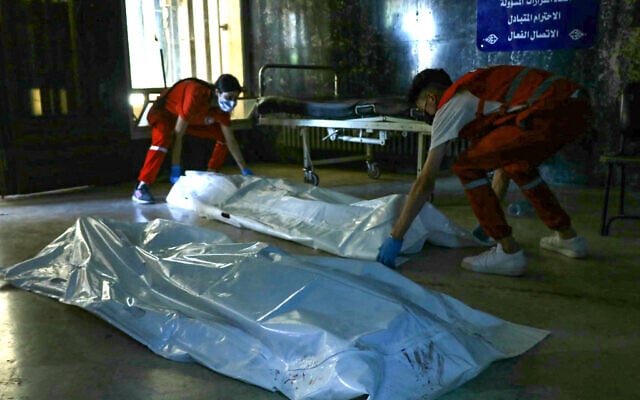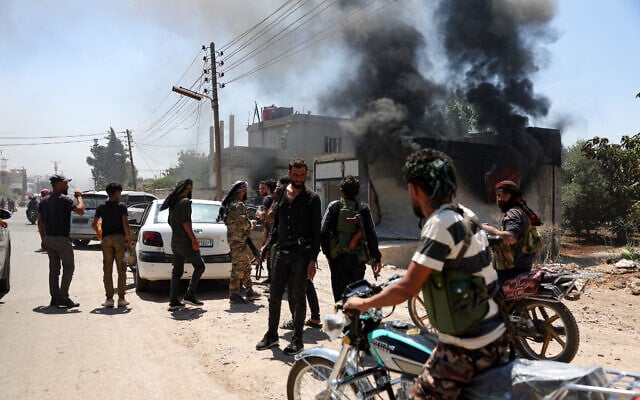



The Syrian Interior Ministry announced Monday that it had launched an investigation following the emergence of footage showing members of the security forces killing and assaulting hospital workers in Sweida last month during clashes between government forces and local Druze.
The Syrian Interior Ministry announced that it opened the probe after the publication of several videos from security cameras at a hospital in Sweida, southern Syria.
Local news outlet Suwayda 24 published Sunday what it said was surveillance footage from the main hospital in the city on July 16, showing a group of people who appear to be staff forced to crouch on the floor in a corridor.
Several armed men are seen standing in front of the group, most wearing military garb and one dressed in an Interior Ministry uniform.
A brief scuffle breaks out with a man who Suwayda 24 identified as “one of the volunteers with the medical team” at the hospital. The forces then shoot the man, whose body is dragged off, leaving a smear of blood.
A doctor at the hospital, speaking on condition of anonymity, confirmed to AFP that the video was taken inside the facility.
In its statement, the Interior Ministry said that it “condemns the incident at the hospital and will directly oversee the investigation to bring those involved to justice.”
Activists have instead called for an independent investigation to probe the violence.
The Syrian Observatory for Human Rights called it a “shocking field execution” carried out by “members of the defense and interior ministries.”
Rights activists called for accountability and an independent inquiry after the footage emerged, following other videos that circulated last month that also appeared to show government forces killing civilians.

Mohammad al-Abdallah, executive director of the Syria Justice and Accountability Centre, said on Sunday that United Nations investigators “must enter Sweida immediately” and labeled the medic’s killing a war crime.
Despite a ceasefire, the situation remains tense in Sweida and access to the province remains difficult.
Local residents accuse the government of imposing a blockade, something officials have denied, pointing to the entry of humanitarian convoys.
A week of bloodshed began on July 13 with clashes between local Druze fighters and Bedouin tribes, but the violence rapidly escalated as it drew in outside forces, eventually killing some 1,600 people, many of them Druze civilians, according to an updated toll by a war monitor.
Syrian authorities have said their forces intervened to stop the clashes, but witnesses, Druze factions and the Observatory have accused them of siding with the Bedouin and committing abuses against the Druze, including summary executions.

Also on Monday, the Israeli military said troops arrested an arms dealer overnight in the southern Syrian village of Trinjeh, inside the Syrian buffer zone.
The raid was conducted by the 226th Reserve Paratroopers Brigade, with support from field investigators in Military Intelligence’s Unit 504. The arrest followed intelligence leads and prior surveillance, the military said. Weapons discovered in the area were seized, and the suspect was taken in for questioning.
According to the IDF, forces remain deployed in the sector to block the entrenchment of terrorist elements in Syria and safeguard residents of Israel, particularly in the Golan Heights.

Israel has been involved militarily in Syria since the fall of the Bashar al-Assad regime in December 2024. In the immediate aftermath, Israel occupied Syria’s demilitarized zone and destroyed most of the Assad military’s facilities in a widespread bombing campaign.
Since the fall of the Assad regime, the IDF has been deployed to nine posts inside southern Syria, mostly within the UN-patrolled buffer zone.
Troops have been operating in areas up to around 15 kilometers deep into Syria, aiming to capture weapons that Israel says could pose a threat to the country if they fall into the hands of “hostile forces.”
In recent months, the IDF said ground troops had conducted over 300 “routine operations” in southern Syria, including arresting suspected terror operatives, preventing “enemy entrenchment,” and thwarting arms smuggling to Lebanon.
The military has also been constructing a barrier, dubbed “New East,” along the Israeli-Syrian border, which resembles a trench to prevent the crossing of vehicles.
